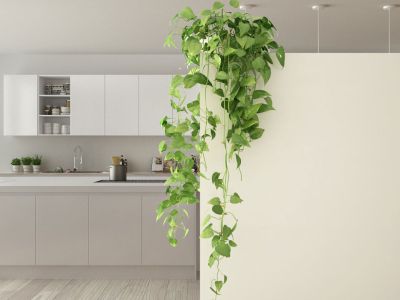How to Grow Climbing Houseplants
Since vines tend to grow voraciously and often without regard to parameters, care of indoor vines requires regular pruning, training onto a trellis or the like, and monitoring water and food needs. Often indoor climbing plants are sold in hanging baskets so the vining arms dangle down from the pot. Light conditions vary according to the variety of plant chosen.
Common Indoor Vine Plants
There are a number of indoor climbing plants on the market. Here are some of the more common indoor vine plants: Philodendron: One of the most common comes from the large Philodendron genus, amongst which there are 200 species with some climbing varieties and some non-climbing. Climbing varieties are usually grown in hanging pots and have aerial roots along the stem which attach themselves to any available support. They prefer indirect sunlight, periodic watering, and occasional feeding. Pothos: Often confused with philodendron is the Pothos or devil’s ivy (Scindapsus aureus). Like the Philodendron, the leaves are heart shaped, but variegated with yellow or white. This versatile plant can grow 6 inches (15 cm.) across with leaves 2 to 4 inches (5-10 cm.) across. Again, this plant is most often grown in hanging baskets or it can be grown on an upright support or “totem.” Growing Pothos climbing vine indoors is an easy exercise. The plant does well in any light exposure, needs only enough water to prevent wilting, and thrives with regular pruning to restrain vine length. Swedish ivy: Swedish ivy, or creeping Charlie, has scalloped, shiny green foliage that hangs down in long arms and is available as a variegated variety as well. This rapid grower tolerates low to moderate light, but truly thrives near a window. Again, usually found growing in a hanging basket, Swedish ivy can be pinched to encourage fuller growth. Spider plant: Spider plant is another indoor climbing plant that is nigh indestructible. This specimen has variegated green and white striped leaves with long stems off which the spider shaped plantlets grow. The plantlets develop roots that can easily grow into new plants if touching soil. Pinching stems will encourage branching. Inch Plant: Several varieties of inch plant are available, with the most popular a purple and silver variegated variety. Another rapid grower, a single plant can spread several feet (1 m.). Remove old stems and leaves to allow for new growth and pinch the long arms to encourage thicker growth. Both inch plant and spider plant will grow in most any light exposure, including under fluorescent lights in an office setting. Other common indoor vine plants include:
Mandevilla (Mandevilla splendens) and its cultivars Black-eyed Susan vine (Thunbergia alata) Bougainvillea
I also once grew a climbing jasmine successfully in a corner window encompassing every corner of a southwestern exposure in the Pacific Northwest.
Care of Indoor Vines
Much as outdoor climbers, climbing vines grown indoors will need to be clipped back on occasion to restrain their rigorous lengths. This will also encourage a bushier mien and foster more blooms. Pruning is best done in the spring before the onset of new growth. If the plants are a really rapid grower, you may need to prune again in the fall. Prune just above a node or swelling where a leaf was. Indoor vines also need something to climb on or be planted in a hanging pot. They can be trained over doors, around windows, allowed to loll along bookcases, or trailing down a wall. Monitor water needs carefully. Most of the above plants are pretty tolerant of too little irrigation, but the most common killer of houseplants is overwatering. Wait until the soil is totally dry before watering and allow to dry thoroughly before you water again. Plants need less water in the winter. Ideally, water the vine in the morning. Don’t forget to fertilize, especially during the growing season. The indoor climbing vine may also need to be repotted on occasion. Go up two pot sizes and transplant in the spring to keep your indoor climbing vine healthy and vigorous.
